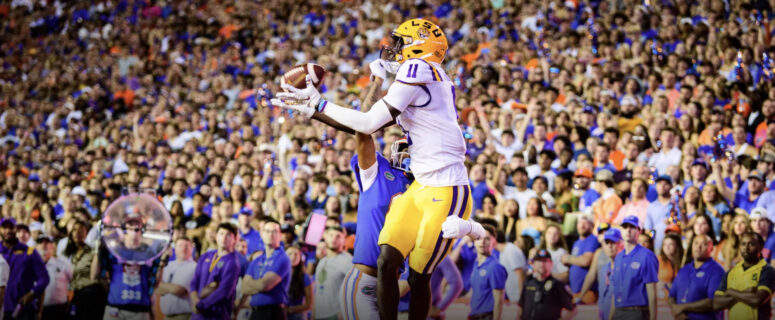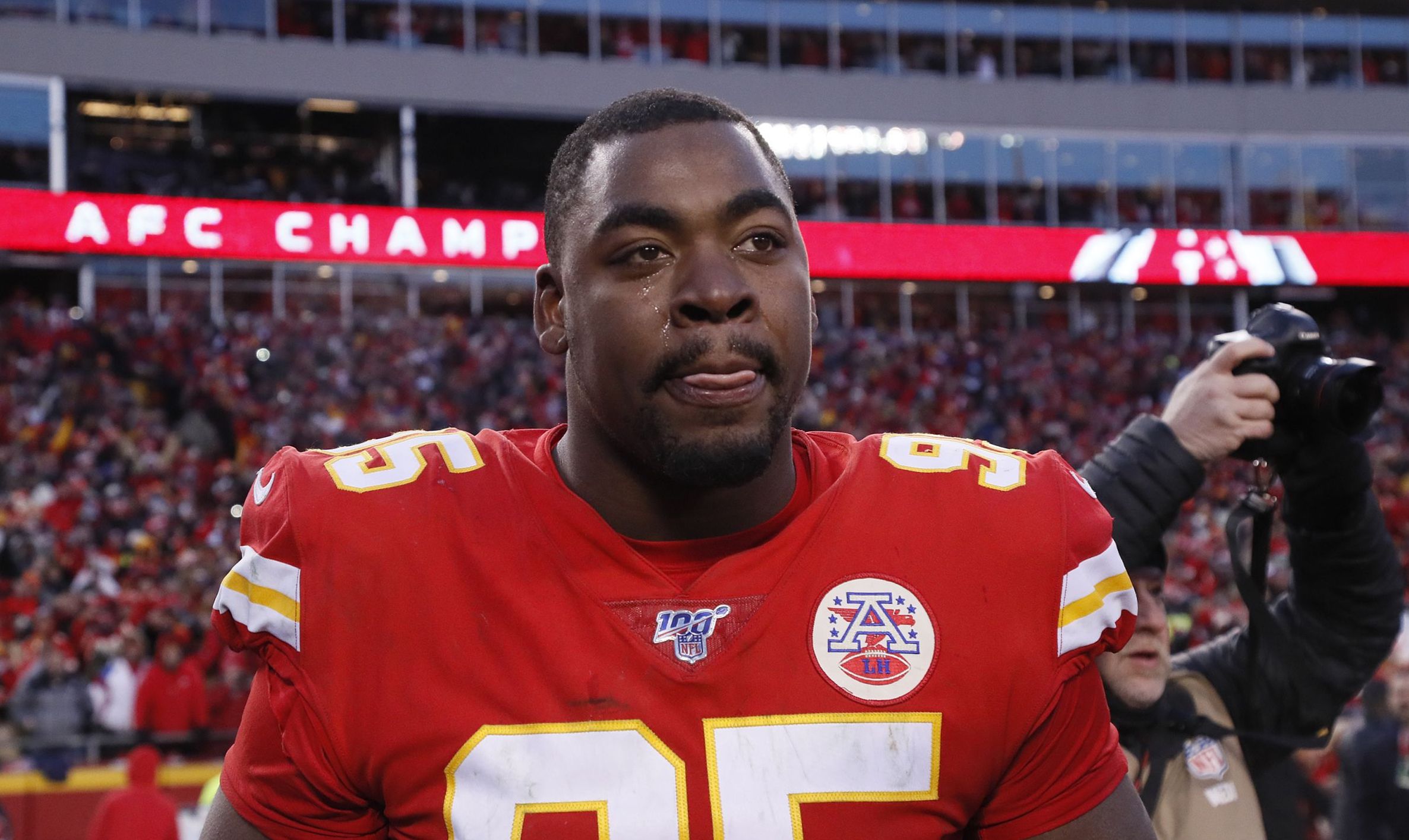KANSAS CITY, Mo. — We’re less than a week away from the NFL Draft, and we’re deep in mock draft season. In the Chiefs Digest mock draft 2.0, it’s time to get aggressive.
For this mock draft, we’re sticking with the Pro Football Focus simulator because I want some consistency from mock draft 1.0, and I want to make some trades, and they have a decent trade AI. We’re going middle settings for public versus the PFF board and positional value. We’re going higher on draft for needs and lower on randomness. I want teams making smart decisions in this draft without much good luck coming my way.
Round 1, No. 25 overall: WR Brian Thomas Jr., LSU
The first five selections unfolded more or less as expected. I faced my first trade consideration with the New York Giants on the clock at No. 6 but their asking price proved too much. It would take No. 32, next year’s first-rounder, a second-round pick and a 2025 third-round pick (from Tennessee via the L’Jarius Sneed trade) for the chance to take Notre Dame tackle Joe Alt, whom the Giants selected. It would have taken a similar price to get tight end Brock Bowers before he went to Atlanta at No. 8.
There wasn’t much consideration for making a trade after that through the 22nd pick. With Philadelphia on the clock, I’m happy with a couple of different players so I don’t have the urgency to make a deal. The Eagles selected Clemson cornerback Nate Wiggins, who wasn’t a player I was targeting.
The Minnesota Vikings at No. 23, however, take Georgia tackle Amarius Mims, and that’s one player off my draft board. Dallas then takes Duke tackle Graham Barton, and Green Bay is on the clock at No. 25. An offer is extended to the Packers: No. 32 plus the 2025 third-round pick from Tennessee for No. 25. They accept.
And with that, Thomas is a Chief, and a steal at that. Widely considered one of the four best receivers in this year’s draft class and has drawn comparisons to Cincinnati’s Tee Higgins. The 6-foot-2, 209-pound Thomas posted a 4.33 40-yard time at the NFL Combine, illustrating a blend of size and speed that’s hard to find. The idea of Hollywood Brown, Travis Kelce, Rashee Rice and Thomas on the field with Patrick Mahomes is frightening for NFL defenses.
Adonai Mitchell from Texas and Georgia’s Ladd McConkey went off the board at No. 29 and 30, so trading up to get a receiver proved a wise call.
Other options at No. 25: CB Kool-Aid McKinstry, Alabama; C/G Jackson Powers-Johnson, Oregon; OT Tyler Guyton, Oklahoma; and OT JC Latham, Alabama
Options if staying at No. 32: WR Troy Franklin, Oregon; CB Ennis Rakestraw, Missouri; and DT Braden Fiske, Florida State
Round 2, No. 64 overall: DE Marshawn Kneeland, Western Michigan
One lesson learned during the first mock draft is what is usually true in the real NFL Draft. For most teams there’s a top tier of 15-20 players, then there’s another 30 that are second-round caliber. After that, the line between third- and fourth-round players is fine and often indistinguishable. Staying at No. 64 wasn’t my plan.
Unfortunately, a significant chunk of my next best 30 players went quickly in the second round. Franklin, Rakestraw, Robinson and Fisk were all gone by No. 43. Jumping into the top 45 would be nice but costly.
I’ve invoked a house rule of not trading with an AFC team in the first three rounds — attempting to mimic some real-life obstacles. The player I’m targeting now late in the second round is Kneeland. The Rams wanted No. 64 and a third-round pick to swap for No. 52, and that’s more than I’m willing to pay. I offered to swamp Tampa Bay No. 64 and 95 overall for No. 57 and 125 overall but they also declined. I am unwilling to upgrade the picks I was sending or reduce the quality of the selection I was getting back.
Fortunately, in this mock draft, Kneeland fell to No. 64, and a trade was unnecessary.
Other options: DT Ruke Orhorhoro, Clemson, LB Jeremiah Trotter Jr., Clemson, OT Patrick Paul, Houston and WR Jalen McMillan, Washington
Round 3, No. 95 overall: OT Patrick Paul, Houston
I find it hard to believe Paul will remain on the board at No. 95 but he’s the type of player worth trading up for in the third round if necessary. Paul has the size — 6-foot-7, 331 pounds, 36 1/4-inch arms at the NFL Combine — and credentials as three times first-team all-conference, including in 2023 during Houston’s first year in the Big 12.
He started 44 games at left tackle over five seasons with the Cougars and was a three-time all-conference selection and a two-year team captain. That experience would be a plus if the Chiefs ask him to start at left tackle as a rookie. If he successfully pushes Wanya Morris to win the starting left tackle job and serves as aprentice and backup behind Morris and Jawaan Taylor until eventually succeeding Taylor at right tackle, this would be a winning pick.
Other options: TE Ben Sinnott, Kansas State; DE Austin Booker, Kansas; DT Michael Hall Jr., Ohio State; and OG Christian Mahogany, Boston College
Round 4, No. 131 overall: RB Will Shipley, Clemson
The Chiefs offense with Patrick Mahomes is dynamic as is but the first half of the 2018 season with Kareem Hunt in the backfield showed how the right running back can take it to another level. It’s not fair to start the Hunt (5-foot-10 1/2, 216 pounds coming out of Toledo) comparisons yet, but Shipley (5-foot-11, 206), has the size and metrics to make one’s imagination take flight.
Injuries hampered him during his junior season but Shipley rushed for 2,748 yards and 31 scores in 36 games with 27 starts, averaging 5.2 yards per carry. His contact balance and skills in the passing game (85 catches for 602 yards and two touchdowns in his college career) also make him an appealing candidate. At worst, Shipley looks like a capable third-down back in the mold of Jerick McKinnon. At best, he could push Isiah Pacheco as starter and give Kansas City a thunder-and-lightning combo in the backfield.
Other options: WR Luke McCaffrey, Rice; DT Maason Smith, LSU; and DT Mekhi Wingo, LSU
Round 5, No. 173 overall: C Beaux Limmer, Arkansas
Round 5, No. 174 overall: S Kitan Oladapo, Oregon Stat
On the clock at No. 159, there were a few interesting players on the board but there were two clubs interested in acquiring the pick. Dallas offered the best deal, sending No. 174 overall, No. 244 and a 2025 seventh-round selection for the opportunity to move upu 15 spots. That gives the Chiefs back-to-back selections later in the fifth round.
The first choice is easy. Limmer has good size (6-foot-4, 302 pounds) and strength (39 reps on the bench press at the Combine). He played at all three interior positions for the Razorbacks, starting 28 games at right guard, 12 at center and one at left guard. Dane Brugler of The Athletic notes that he’s well-suited for the outside-zone run scheme employed by the Chiefs. If Joe Thuney, Creed Humphrey or Trey Smith don’t return in 2025, Limmer can start at all three spots.
Oladapo is a more difficult choice because there are several options available. With Justin Reid entering his contract year, depth at safety is a plus for the Chiefs. Oladapo is a sixth-year senior so he will turn 24 in October but he’s a hard hitter who can play in the box and should excel at special teams — think of him as Dan Sorensen 2.0. Oladapo should project as a capable No. 3 safety behind Bryan Cook and Chamarri Conner going forward.
Other options if staying at No. 154: OT Caedan Wallace, Penn State; OG Zak Zinter, Michigan; and Limmer
Other options at No. 174 and 175: S Beau Brade, Maryland; S Josh Proctor, Ohio State; LB Ty-Ron Hopper, Missouri; and DT Khristian Boyd, Northern Iowa
Round 7, No. 221 overall: TE Tanner McLachlan, Arizona
The 25-year-old Canadian eschewed a basketball scholarship in Alberta in favor of playing football at Southern Utah, and he finished his college career at Arizona with two strong campaigns. The 6-foot-5, 244-pound McLachlan caught 79 passes for 974 yards and four touchdowns for the Wildcats, earning All-Pac-12 honorable mention last season. His 79 catches are the most for a tight end in Arizona school history, eclipsing the 75 by Rob Gronkowski.
He’s not necessarily the heir apparent to Travis Kelce but should be a productive receiver with red-zone capabilities thanks to his size.
Other options: WR Joshua Cephus, Texas-San Antonio; DT Fabien Lovett, Florida State; and DT Jowon Briggs, Cincinnati
Round 7, No. 244 overall: CB Tarheeb Still, Maryland
Cornerback isn’t a huge need for the Chiefs even with the departure of L’Jarius Sneed but taking a flyer on a late-round cornerback for coach Dave Merritt to mentor hs repeatedly worked out for Kansas City. Still was a productive defensive back with six interceptions and 28 passes defended in 39 college games.
He doesn’t have huge size (5-foot-11, 189 pounds) but Brugler notes he projects best as a nickel defender in a zone-heavy defense, and he enjoys getting physical in press coverge. That’s a perfect fit for a Steve Spagnuolo defense.
Other options: S Millard Bradford, TCU; CB Qwan’tez Stiggers, Toronto (CFL); and OG Jacob Johanning, Furman
FINAL GRADE: B-plus
The PFF simulator liked this draft better than mock 1.0, awarding high marks to the Thomas (A), Kneeland (A-minus) and Paul (A) selections. The lowest mark went to Shipley (C-minus) while Oladapo(B-minus) received the highest grade from the third-day picks.
My self-assessment has two criticisms. One is the lack of a second receiver selection, although there is reason to believe the Chiefs aren’t showing a great deal of interest in receivers outside the second round. The second is not landing an interior defensive lineman. The Chiefs have shown interest in a defensive tackle among the first three rounds, and that could be a sneaky selection on day two of the draft. The Chiefs have only Chris Jones and Neil Farrell under team control beyond the 2024 season.


